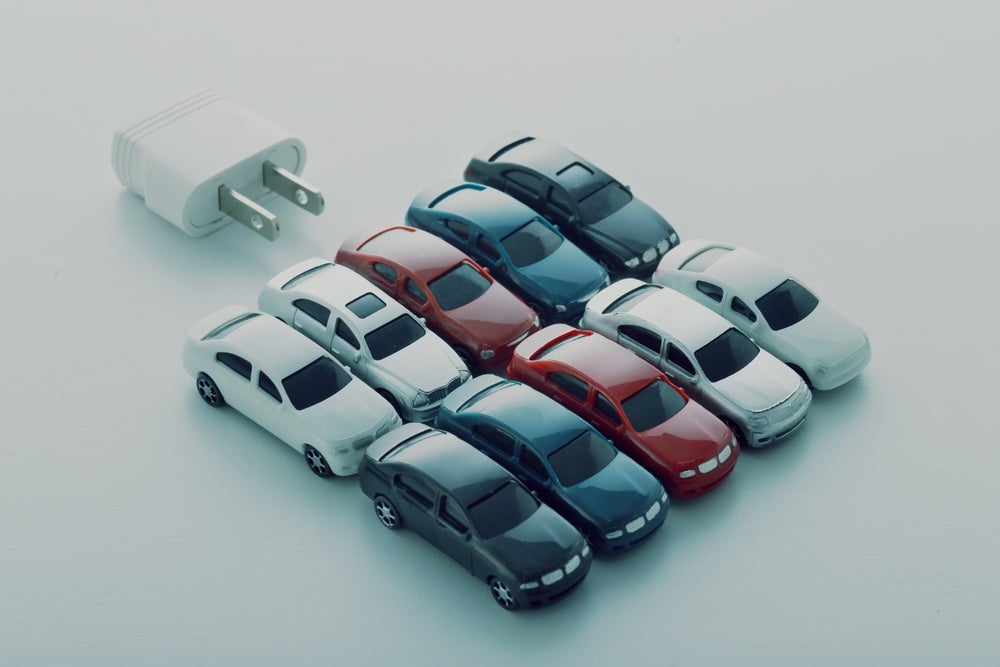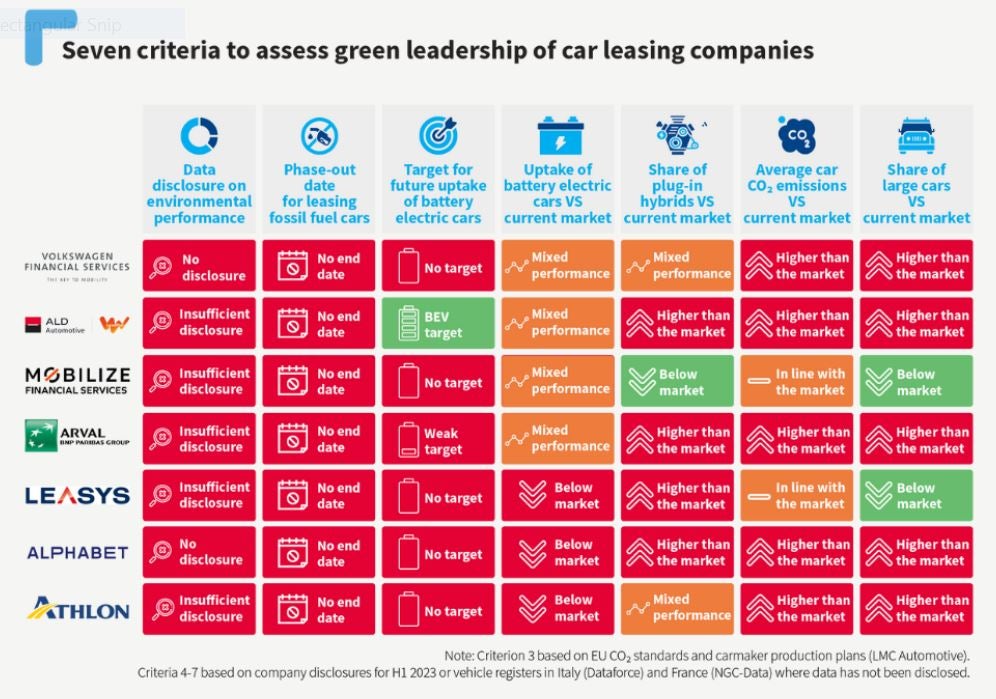
Half of the new cars in the European Union are not bought but leased. This reflects not only the changing relationship consumers have with car ownership, but the evolving power dynamics between the market, the leasing companies, and the banks and car manufacturers that own them.
The top seven of these leasing companies, with a fleet of approximately 9.3 million cars, register 30% of new cars in the EU. With those volumes comes a substantive amount of influence on the industry, and that raises questions about the leasing sector’s role in the transition to zero-emission mobility.
The NGO, Transport & Environment, has recently released a report that attempts to answer these questions, and the answers it gives are not flattering. The report is called “Stuck in the Fossil Age: Are car leasing companies in the EU green leaders or greenwashing?” In the report, T&E assesses the green leadership claims of the seven largest leasing companies, as well as the leasing sector as a whole.

T&E’s analysis focused on seven criteria to judge the performance of the EU leasing market. These criteria were the firm’s data disclosure on environmental performance, the presence of a phase-out date for fossil fuel cars, and a defined target for the future uptake of battery electric cars. The firms were measured against the current market to judge their existing uptake of battery electric cars, the proportion of their cars that are plug-in hybrids, and their average car CO2 emissions, as well as their share of large cars in their fleet.
In measuring these criteria, T&E has said that leasing companies are not the climate champions they claim to be. The NGO found that all seven leasing companies refused to share data on their battery electric vehicle (BEV) uptake and none of them had committed to a phase-out date for fossil-fuelled cars.
ALD | LeasePlan [Ayvens] was the only such company to have set a BEV target ahead of carmaker production plans, while Arval had what T&E called “a weak target far below carmaker production plans”, while other leasing companies failed to set BEV targets altogether.
How well do you really know your competitors?
Access the most comprehensive Company Profiles on the market, powered by GlobalData. Save hours of research. Gain competitive edge.

Thank you!
Your download email will arrive shortly
Not ready to buy yet? Download a free sample
We are confident about the unique quality of our Company Profiles. However, we want you to make the most beneficial decision for your business, so we offer a free sample that you can download by submitting the below form
By GlobalDataThe report also called out Alphabet (GB) for a BEV uptake that was far behind the market, as well as the absence of any BEV target, while the largest leasing company, Volkswagen Financial Services (VWFS) was criticised for a lack of any BEV target.
Other car lessors mentioned in the report are Mobilize Financial Services, Leasys & Athlon.
T&E’s calls to action throughout the report are clear. It calls on leasing companies to target a phase-out date of 2028 for polluting vehicles with intermediate BEV targets, promote transparency by disclosing the number of BEVs, PHEVs, and the average CO2 emissions in their new registrations, and improve performance by leading the market in the uptake of efficient and zero-emission vehicles.
An industry responds
T&E is not the only organisation to argue that the leasing sector has an important role to play in driving electric vehicle use.
“As significant purchasers of new vehicles, leasing companies have an important role in the transition to zero emissions road transport,” points out Ben Nelmes, CEO of transport research organisation New AutoMotive.
New and used car retail site Auto Trader has also pointed to the critical role leasing has to play in the energy transition, with Rachael Jones, Director of Automotive Finance at Auto Trader pointing out, “In the UK, when it comes to electric vehicles the leasing sector is without doubt driving engagement significantly ahead of the retail sector. The latest data suggests that around four in five electric car registrations are through various fleet channels, in particular the likes of leasing and salary sacrifice.”
However, observers also point to the important role the government plays in setting the tone for the market, arguing the leasing sector needs regulatory and government guidance.
“Across Europe, we see that leasing companies’ vehicle purchasing is highly influenced by policymakers’ decisions as much as commercial strategy or environmental commitment,” Nelmes says. “In the UK, the Government has reduced taxes on company cars to encourage commercial fleets to purchase electric vehicles, absorb the depreciation costs and then sell them into the second-hand market. Other countries have chosen to incentivise the purchase of electric vehicles by focusing on consumer incentives, meaning commercial fleets lag behind overall electric vehicle sales.”
However, Auto Trader points out that there is still much for the industry itself to do, and points to T&E’s report as a good source of guidance.
“We’re only at the beginning of that journey and there’s certainly more that can be done in many of the key areas identified by the report,” Jones says. “In the case of initial progress, the leasing sector is doing a great job but in terms of what’s ahead of us, there’s still much more to be done and certainly no room for complacency.”
VWFS & Leasys
We approached the seven car leasing companies mentioned in the T&E report for their response. Only VW and Leasys got back to us before publication.
A spokesperson for Volkswagen Financial Services UK, said: “We are committed to electrification, and are advocating for our fleet customers to transition to EVs. In our UK Fleet operations in 2022, EVs made up 46.8% of our total order bank, in comparison, EVs accounted for 16.6% of all UK new vehicle registrations. We continue to support fleets with their EV transition, offering expert advice and innovative solutions to help businesses on that journey.
“Globally, Volkswagen Group is aiming for a BEV market share of 8% to 10% in 2023, rising to more than 50% by 2030 worldwide, and more than 70% in Europe.”
A press release from Leasys said that in the first nine months of 2023, the company registered over 169,000 new contracts in Europe, with 16% allocated to electrified vehicles. The current European fleet managed by Leasys consists of 850,000 vehicles, of which 30% are electric (BEV) or hybrid. This aligns with Leasys’ 2026 target, where it aims for one in every two contracts to involve a green vehicle.
Steering the market
As a major, and growing supplier of motor vehicles to all consumers, the leasing industry occupies a position of leadership that it can use to affect consumer behaviour on a large scale. Companies in the sector can use their platform to promote the benefits of all environmentally friendly vehicles, with particular emphasis on electric cars. As Jones points out, as the consumers’ point of contact with the car industry, leasing firms can “simplify jargon whilst fighting the fear, uncertainty and doubt that confuse conversations around electric vehicles.”
Of course, when it comes to helping the customer see through the jargon, there are few areas where this is more necessary than in motor finance.
“It’s also important to demystify the financial side of leasing electric vehicles to make the overall buying experience easier and to make clearer comparisons – notably through total cost of ownership calculations,” Jones argues. “Because of its position in the industry, the leasing sector can also help their business partners to work out how best to support their drivers with the right type of infrastructure help, whether that be home chargers, office solutions or regional depots.”
The leasing industry’s responsibilities and influence here are not just as an educator and guide in the market but as a consumer.
“The leasing sector is one of the biggest purchasers of new vehicles and has a key role to play in the transition to electric vehicles,” Nelmes argues. “If commercial fleet operators lead the purchase of electric vehicles, it will benefit consumers by providing cheap second-hand electric vehicles with companies absorbing the depreciation costs.”
Too little, too late?
But the question that T&E asks remains. Is the leasing industry doing enough to drive the transition to electric vehicles? There is no denying the leasing sector is playing a crucial role, and that playing that role exposes businesses in the sector to risk.
“Many leasing companies are leading purchasers of electric vehicles and are navigating significant challenges such as uncertain and fluctuating residual values,” Nelmes says. “Every leasing company should be looking to grow its electric vehicle purchases, but there can be barriers to this outside of the companies’ control, and policymakers play a key role in ensuring that the sector can decarbonise.”
The biggest bone of contention with T&E’s report seems to be the deadline of 2028 for the leasing industry to switch entirely to electric vehicles. Like many others in the motor industry, large parts of the leasing industry are focused on a 2030 deadline for the transition. Tusker, a provider of salary sacrifice car schemes, has been a member of the EV100 since 2020. As part of the EV100, Tusker pledged to transition 100% of its fleet to EV by 2030.
“It has remained committed to this pledge, even after the Government’s ban on ICE vehicles was pushed back to 2035,” says Paul Gilshan, CEO of Tusker. “With seven years to go before this date, Tusker is well on the way to achieving this ahead of time, with a fleet of more than 35,000 vehicles and orders placed to bring the fleet to 73% EV, 15% ULEV and just 8% ICE.”
Still, others argue in favour of the 2028 deadline, while still pointing out that meeting it will require a great deal of work.
“2028 is a realistic target, but to make it happen collaboration is a must,” Nelmes says. “We need to see both private and public bodies engaging with each other, and working towards constructing robust policy.”
The technology and products available will also be a deciding factor.
“The main challenge for the leasing sector has been the supply of zero-emission vehicles,” Nelmes points out. “If we want to see this remedied, the EU’s passenger car CO2 regulations may need to be strengthened and national level policies should focus on improving vehicle supply rather than protectionist measures that slow the transition.”
With car manufacturers already shifting production towards electric, and with the supply of internal-combustion-engine-powered cars expected to dwindle, the task is looking increasingly manageable. Battery technology is advancing quickly, and the cost of production will continue to come down as scale grows, reducing in price as the new technology comes to market.
“That should lead to greater choice and affordability in all segments, removing today’s biggest barrier, upfront cost,” Jones says. “Allied with the fast-growing infrastructure rollout, the new range levels should remove the other big barrier of charging anxiety.”
Jones also points out that familiarity will be a great driver, with people’s day-to-day experiences around EVs promoting a better understanding of the product. One large sector of the leasing market, however, may prove to be more of a challenge.
“It’s harder to remove vans from leasing circulation – the van choices, costs and ability to charge easily need to get better in order to enable high mileage van fleets to run efficiently,” Jones says.
Looking to the future, many across the leasing sector also point to concerns around the value of their vehicles as they enter the used vehicle market later.
“Another problem is the uncertainty around the future of residual values,” Nelmes says. “We’ve seen these fluctuate across all market segments and fuel types over the course of the pandemic, and until these stabilise, people will be wary. “
Jones also points to declining values as an obstacle for the EV transition to overcome.
“The decline in values seen in the last year – i.e. the 22% decline in one year, leading to three-year 30K mile RVs in the low 50%, – will have damaged confidence and will definitely impact the leasing sector’s approach to electric vehicles,” Jones forecasts. “The well-documented price dips are going to cost funders who have those cars on their books a lot of money when they come to remarketing them as used cars. They also need retailers ready to buy and sell used EVs and equally healthy consumer demand for them – we are seeing supply and demand increase in the used EV market, but this needs to keep pace with the volume entering the used market.”
Possible remedies
Coming full circle, the question remains – should the transition be led by the industry or the policymakers?
“There are two things policymakers need to be doing,” Nelmes urges. “First, the EU needs to ensure that there is a sufficient supply of zero-emission vehicles arriving into the continent for commercial leasing companies to purchase. Second, they need to get the right incentives to promote electric vehicles to commercial leasing companies’ customers.”
Nelmes tells us this could take the form of company car tax reforms or other grants or incentives. Combining these with concrete commitments to electric vehicles and clear targets for the commercial leasing sector, Nelmes says would help Europe seamlessly transition to electric vehicles.
Jones also points to government intervention that could aid the switch, telling us, “The leasing sector would benefit from more targeted government support on used electric cars, to ensure that market can flourish as that’s incredibly important to driving mass adoption.”
Jones suggests the government could match VAT on public and private charging, helping to bring down costs and ensure local authorities and planning processes enable, rather than stifle, the rollout of charging infrastructure. But this is a process that must occur in parallel with activity in the private sector.
“Car manufacturers are making progress in reducing their prices as they reduce their production costs, notably with battery prices, and gain the benefits of growing scale and this will be helpful for leasing companies who will then see more attractive monthly offers,” says Jones.
Whatever progress has been made so far; Jones warns against the leasing sector resting on its laurels.
“There’s certainly a willingness to move things forward and we’re seeing that initial progress in the leasing sector but in terms of what’s ahead of us, there’s still much more to be done, and this is certainly not a time for complacency,” Jones says.
Ultimately, it is only through collaboration between government and the private sector that these targets can be achieved.
“Leasing companies should commit to ambitious EV targets and then actively engage with governments to ensure that supportive policies accompany those targets,” Nelmes says.
Griffin Carpenter, who worked on the T&E report as well as three other reports on the role of leasing in the transition to EVs, believes that 2028 is the latest point at which a target can be called ambitious.
“The only question then is what that level of ambition should be,” Carpenter says. “For their part, many OEMs, including the owners of major leasing companies, have answered this question with a 2030 ICE phase-out date. So, if you think that leasing companies should be leading the transition – and leasing companies are keen to say this is how they see themselves – that means a higher ambition and an earlier phase-out date.”
T&E has run the numbers and believes a 2028 phase-out date for the major leasing companies is fully compatible with current OEM production plans.
“This means that if leasing companies want to claim that they are ‘driving the transition’ then a 2028 phase-out date is the standard,” Carpenter tells us. “I’m afraid that anything less than this puts them firmly in the passenger seat.”
Overcoming barriers to decarbonise in the UK’s HGV sector







